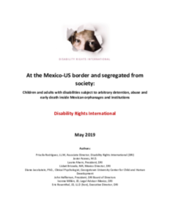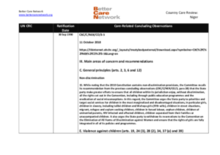Displaying 341 - 350 of 836
Disability Rights International (DRI) carried out two investigation trips to Baja California, Mexico, in November 2018 and February 2019, visiting four residential, private institutions for children and adults – including migrants - with disabilities. This report presents the findings from these investigations.
The webinar recording provides a basic overview of the intersection of early childhood development (0-5), attachment and trauma in young migrant children.
In this cross-sectional study, the authors assessed the mental health of children held at a US immigration detention center over two months in mid-2018.
This article examines the situation of minors from El Salvador, Guatemala, and Honduras who have been forcibly separated from their parents at the southwestern US border.
This book largely focuses on unaccompanied minors who arrived in a European country in 2015, with special attention paid to the top-three nationalities of unaccompanied minors, namely Syrian, Afghan and Eritrean minors.
This country care review includes the care related Concluding Observations adopted by the Committee on the Rights of the Child and the Committee on the Rights of Persons with Disabilities as part of its examination of Niger's initial reports, as well as other care-related concluding observations, ratification dates, and links to the Universal Periodic Review.
In this study, qualitative interview data were used to explore parental separation and coping strategies among newcomer immigrant adolescents in the US.
This webinar offers foundational information related to the intersection of culture, the migration journey, trauma and assessment.
This article focuses on the “zero-tolerance” policy adopted in spring, 2018, in the USA. The implementation of this policy resulted in the forced separation of children from their families and the violation of human rights of those detained in authorized facilities and foster care.
This article focuses on the “zero-tolerance” policy adopted in spring, 2018, in the USA.


